What Lies Beneath a Tiffany Drawing?

Louis Comfort Tiffany (American, 1848–1933); made by Tiffany Studios (1902–1932). Suggestion for Three Upper Windows in Large Hall for the Residence of Mr. T. Eaton, Toronto, Canada, ca. 1904–11. 25 1/2 x 49 9/16 in. (64.7 x 105.5 cm). The Metropolitan Museum of Art, New York, Purchase, Walter Hoving and Julia T. Weld Gifts and Dodge Fund, 1967 (67.654.313)
«For viewers of a large design dated between 1904 and 1911 from the studios of Louis Comfort Tiffany (1848–1933), the first question that might come to mind is, "Why does it look so muted and murky?"»
In Suggestion for Three Upper Windows in Large Hall for Residence of Mr. T. Eaton, Toronto, Canada, now on view in gallery 743 of The American Wing, Tiffany presented a triptych series of windows that feature three seated women representing the muses Music, Literature, and Art for the Toronto residence of a Mr. T. Eaton. For this commission, Tiffany Studios may have collaborated with the artist Farquhar McGillivray Knowles (1859–1932), whose name appears on the left corner of the drawing. Unlike other carefully detailed renderings made by Tiffany Studios—a large array of which are in The Met collection—this design lacks the vividness and complex layering of colors that is distinctive to watercolor. Yet, the overall impression of these three portraits is naturalistic, and some details even feel extraordinarily realistic—for instance, the third muse's hand, in which she holds a pen.

Left: Louis Comfort Tiffany (American, 1848–1933); made by Tiffany Studios (1902–1932). Suggestion for Mosaic Panel, Mrs. Edward Van Ingen, Church of the Redeemer, Patterson, New Jersey(detail), ca. 1921. Watercolor, gouache, gold metallic ink, and graphite on artist's board in original mat, 22 7/16 x 14 3/8 in. (57 x 36.5 cm). The Metropolitan Museum of Art, New York, Purchase, Walter Hoving and Julia T. Weld Gifts and Dodge Fund, 1967 (67.654.18). Right: Suggestion for Three Upper Windows in Large Hall for Residence of Mr. T. Eaton, Toronto, Canada (detail of the third figure, who represents Art)
The work's enigmatic nature stimulated collaborative research by experts in The American Wing, Paper Conservation, and Scientific Research departments of the Museum. In our joint investigation, we found that each watercolor of the triptych was made on a very thin, translucent sheet of paper attached to a single, large artist'sboard. When looking at the surface under the microscope, we saw what appeared to be black-and-white sketches, as well as localized applications of color beneath the translucent papers. In another unusual detail, the microscope revealed small air bubbles trapped underneath the semi-transparent paper, suggesting the paper must have been glued onto existing sketches as part of an experimental design process.
For answers to many of the questions these discoveries raised, we turned to infrared reflectography (IRR), a non-invasive technique traditionally used to peer through multiple paint layers in order to see underdrawings and corrections. With IRR, pigments that absorb the infrared radiation appear dark, while others appear partially or completely transparent. In this case, the infrared camera revealed an unexpected surprise: The images obscured beneath each of the three watercolors, which looked like black-and-white sketches to our eyes, are in fact photographs.
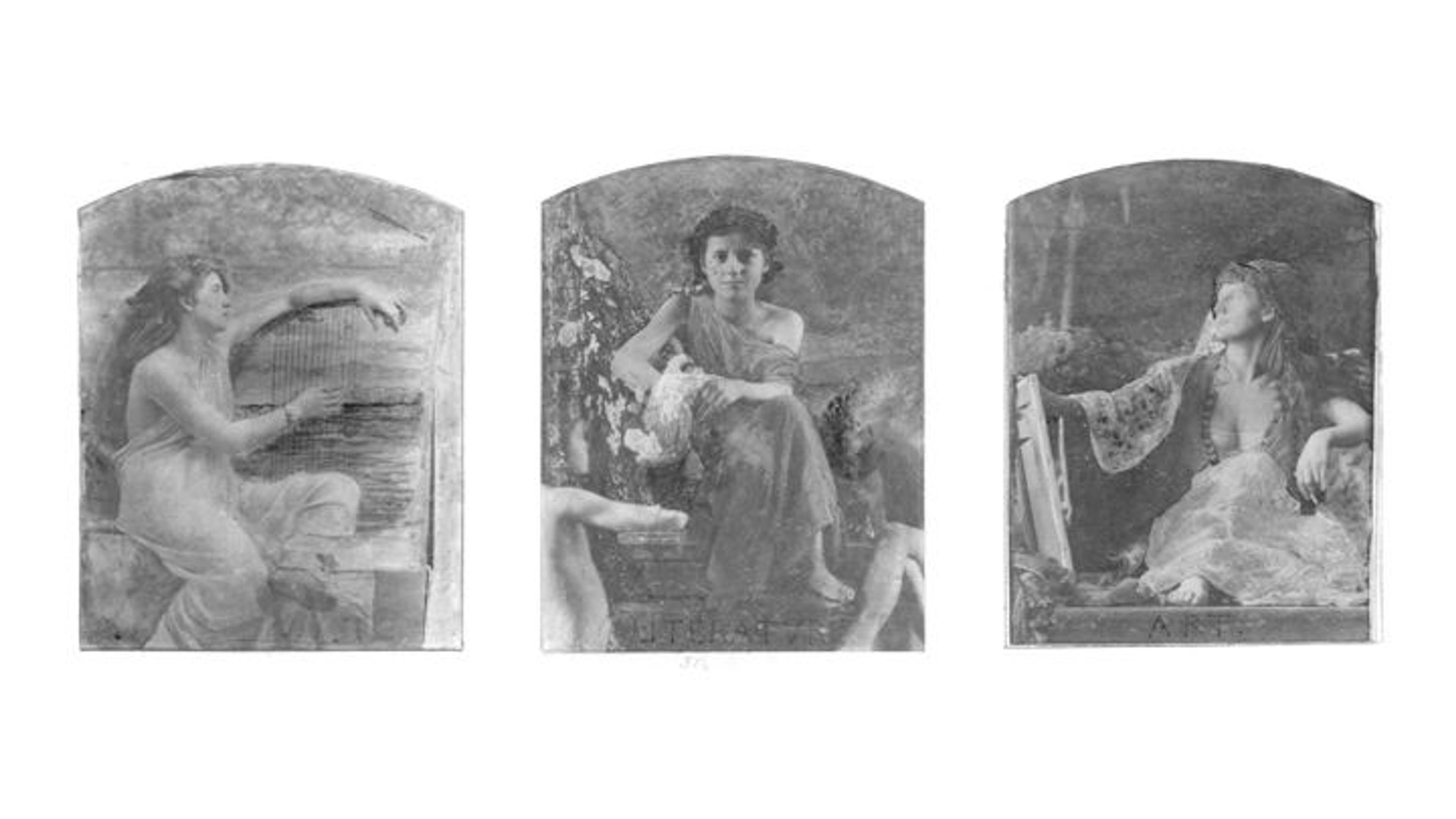
Infrared reflectograms of Suggestion for Three Upper Windows in Large Hall for Residence of Mr. T. Eaton, Toronto, Canada. Photos by the Department of Paintings Conservation, The Met
Thanks to this discovery, we now know that the artists used three photographic portraits of live models taken in a studio setup as the basis for their work. After touching up a few areas with color, they overlaid sheets of translucent paper and painted the image you see with watercolor and gouache. This process unified the background, provided a color scheme, and rendered an overall painterly appearance. The purpose of this unusual working method was likely the expedient rendering of human form.
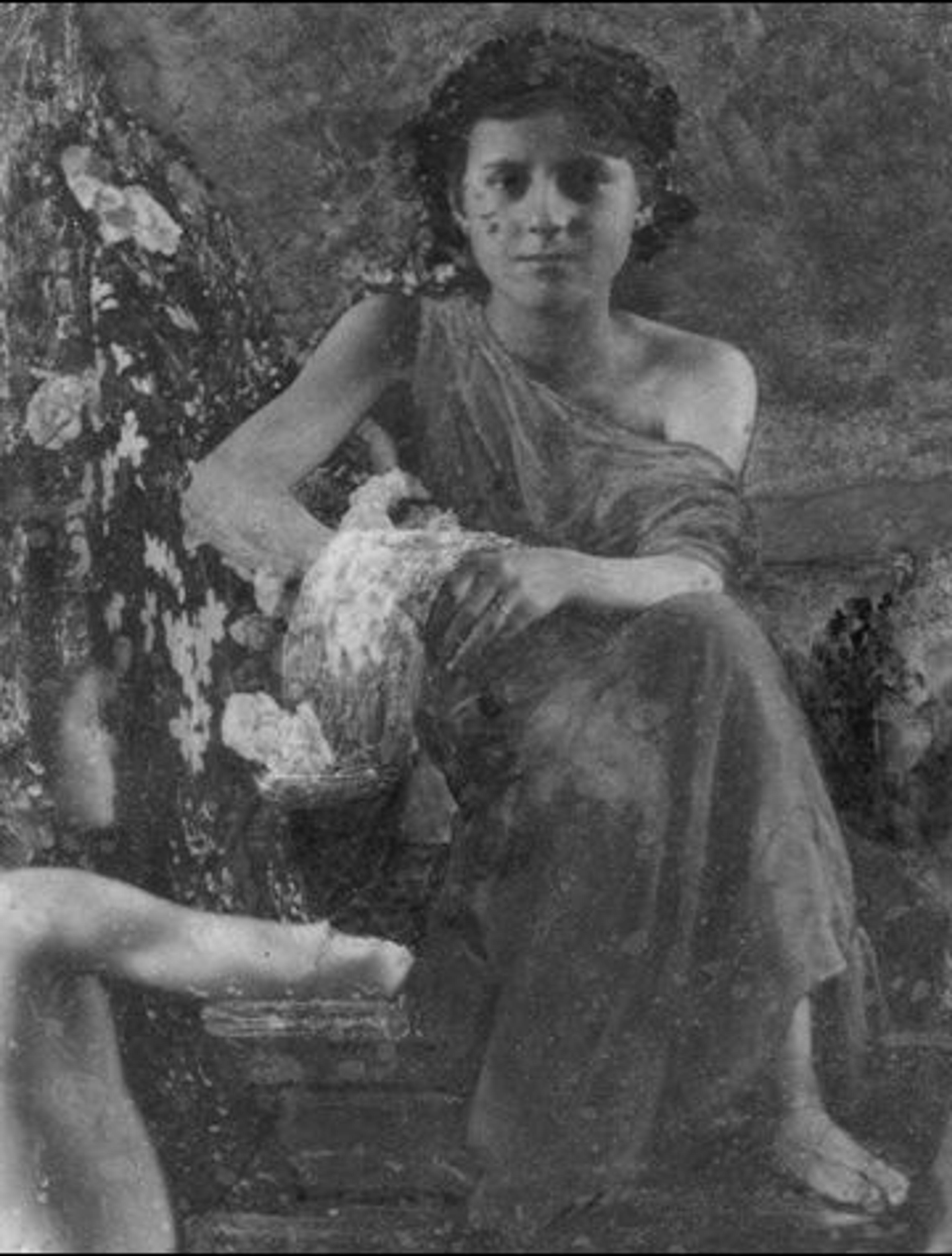
Right: Suggestion for Three Upper Windows in Large Hall for Residence of Mr. T. Eaton, Toronto, Canada (detail of the second figure, who represents Literature, likely Tiffany's niece, Alfreda Mitchell)
IRR enhanced the visualization of details, like the muses' facial features, and unveiled elements that were not visible in the final composition. Most remarkably, the center IRR image shows that the main figure was not alone in the studio when the picture was taken. Two other young models posed for this photo, but were covered over in the final rendition. IRR revealed the head and torso of a figure in the bottom-left and the crossed legs of another in the bottom-right. Furthermore, the right hand and forearm of the figure on the left are blocked out; they seem to have been altered to prevent them from showing through the translucent paper.
We then found ourselves facing a new set of questions: What kind of photographs did the designers use, and how did they manipulate them for their subsequent use as "underdrawings"? Did they alter the negatives using photomontage techniques, or did they use pigments to cover up the areas that were unwanted in the final composition?
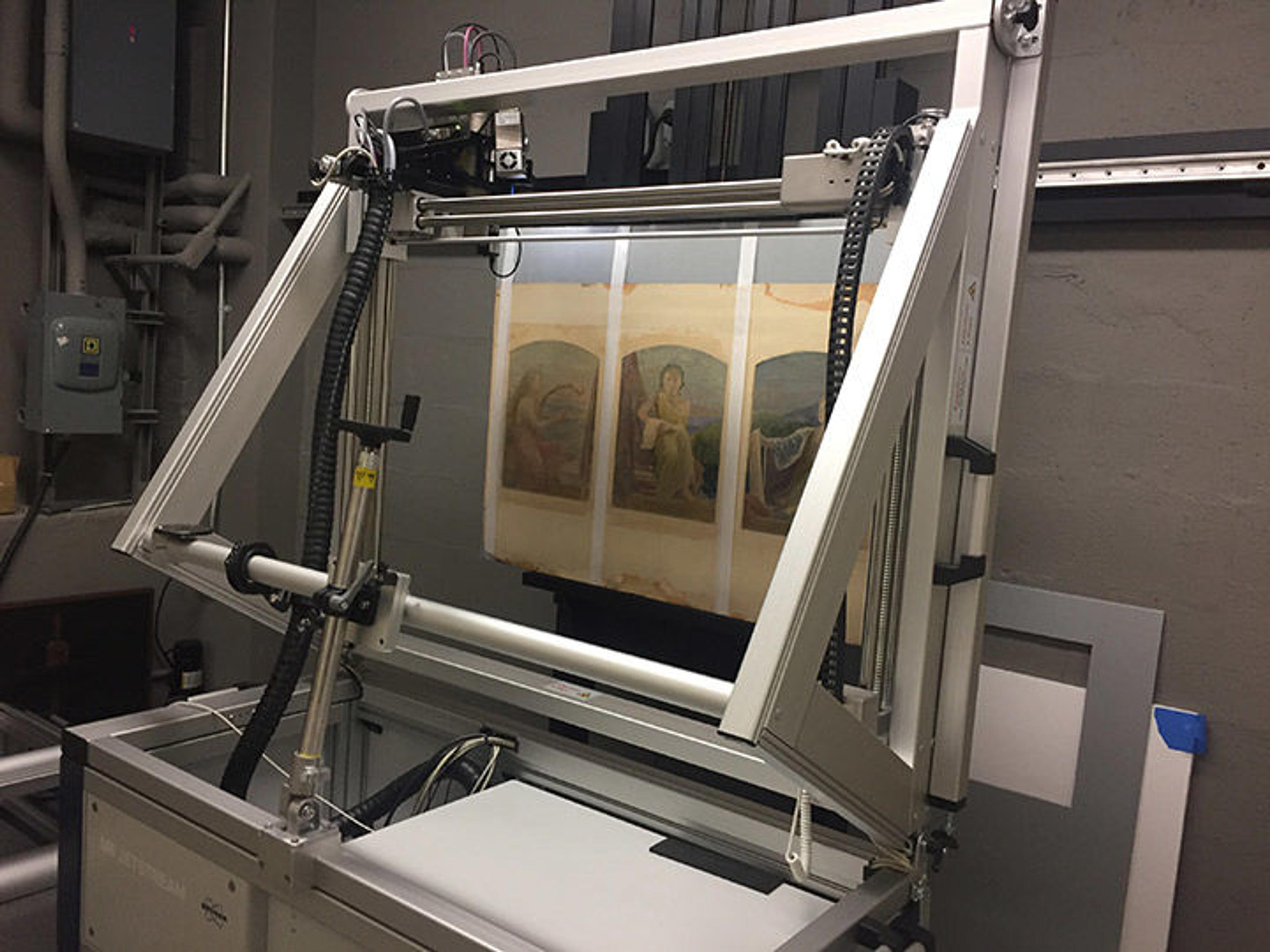
Scanning XRF setup at the Departments of Scientific Research and Paintings Conservation, The Met. Photo by Jalena Louise Jampolsky
Another process, known as X-ray fluorescence (XRF), was used to answer these questions. By shining X-rays on an object, we can learn what elements are present and in what amounts. When X-rays come into contact with the atoms in the object, they're prompted to emit secondary X-rays, which can be matched to the specific materials. To better understand how the underlying photographs are related to the watercolors, we scanned a small region of the center panel, where the forearm and the hand of the figure on the left had been blocked out. In this way, we measured the distribution of different elements in the object, without ever touching its surface or removing a sample.
The XRF map revealed silver in the area we scanned, which suggests that the underlying image is a silver-based photograph. In silver photographs, dark areas are made by the presence of silver particles, while highlights are due to a lack of silver. In the silver distribution map, we can see the outline of the figure's entire arm. What's notable to observe here is that there is less silver on the sitter's arm than in the surrounding area (evidenced by the absence of silver particles on the XRF map). This indicates that even though the sitter's hand does not appear in the final watercolor, the photographic negative was most likely not manipulated to remove the sitter's forearm and hand.

Left: GIF revealing layers of visible light, silver XRF distribution, silver with yellow outline of removed arm, copper XRF distribution, and calcium XRF distribution, respectively. Photos by Louisa Smieska and the Departments of Scientific Research and Paintings Conservation, The Met
Instead, the presence of other elements, including copper and calcium, suggest that pigments were used to block out the area. When seen through IRR, the forearm and hand appear dark because certain compounds in the overpaint absorb the infrared light. By matching some of the dark areas in the IRR to the XRF maps, we can understand which pigments absorb infrared light. For example, XRF shows that the hand was painted over with a copper-rich pigment, matching a dark area in the infrared image. Similarly, the forearm is covered with a calcium-rich paint, in a shape that matches the area blocked in the IRR map. Further tests would be needed to identify the exact pigments.
However, an intriguing question remains: If the photograph in the center panel was carefully manipulated and integrated into the creation of the Eaton window commission, does this mean that Tiffany and his studios were repurposing studio portrait photographs?
In short, the answer is yes. Tiffany's studios revisited similar figures in strikingly different settings, mediums, and styles. Several of the models portrayed in the photographs that lie beneath the Eaton window design can also be seen in other prominent works by Tiffany Studios produced over the span of several decades.
According to accounts by members of his family, Tiffany photographed relatives during their visits. The model personifying Literature in the center panel is likely Tiffany's then-adolescent niece, Alfreda Mitchell, who is also featured in the artist's painting The Blossoms of Spring, made between 1887 and 1898, many years before the Eaton window commission. In the painting, Alfreda is surrounded by two young figures who recall those eliminated in the design drawing. All three figures are captured in slightly different angles in both compositions.
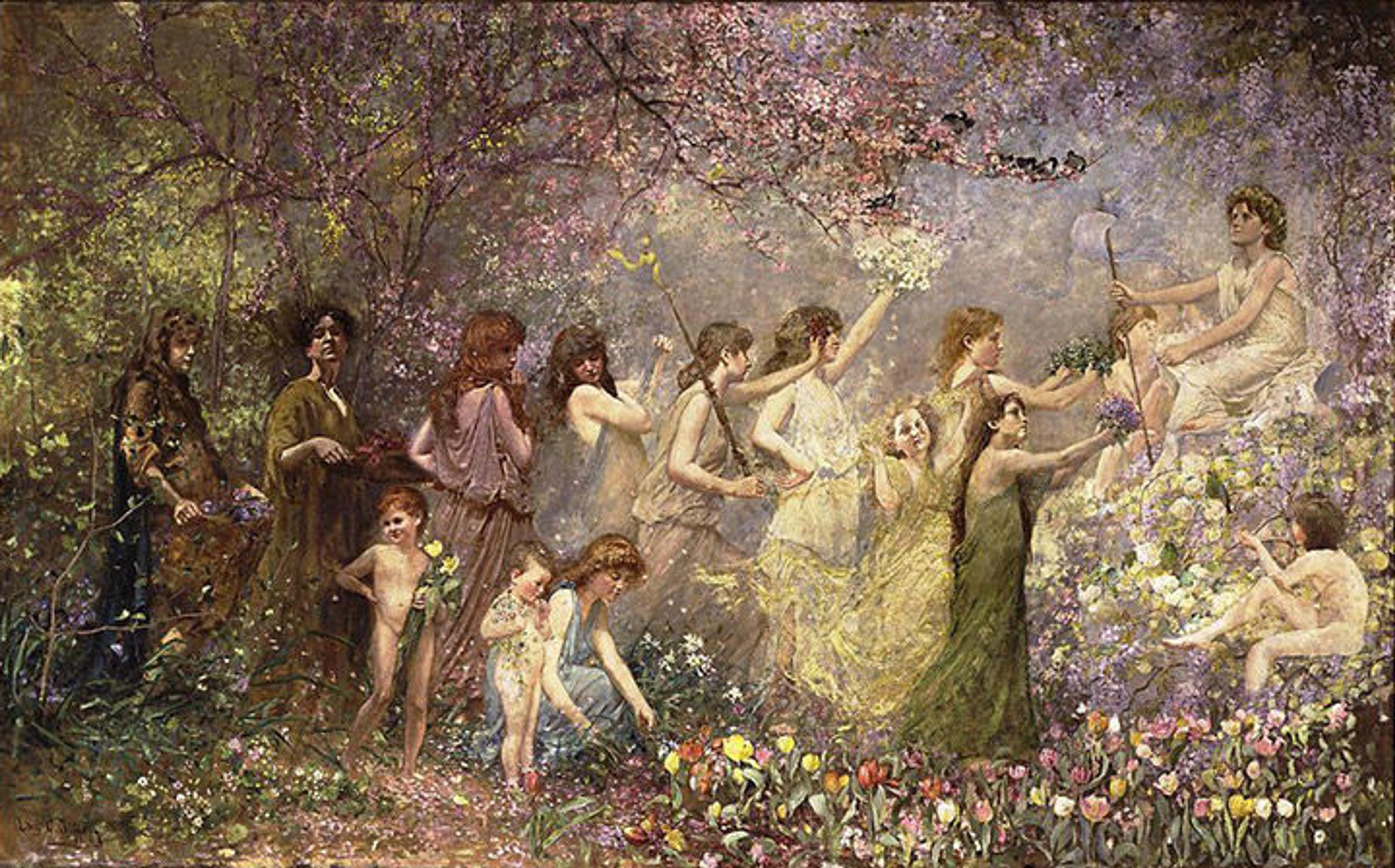
Louis Comfort Tiffany (American, 1848–1933). The Blossoms of Spring (also known as Flora and Spring), c. 1887–98. Oil on canvas, 66 1/2 x 101 in. (167 cm x 256.5 cm). The Morse Museum of American Art, Gift of the Estate of Alfreda Tiffany Mitchell Bingham Gregor, 1874–1967
Similarly, the model who represents Art in the right panel of the drawing is semi-reclined, and poses holding a canvas in her right hand. The same model, wearing an identically stylized vest and headdress, is depicted in a similar pose in a leaded-glass window installed at Yale University in 1890. The composition angles have been shifted slightly and the whole picture is inverted, but a photograph taken during the same session was evidently used as inspiration for the Yale window.
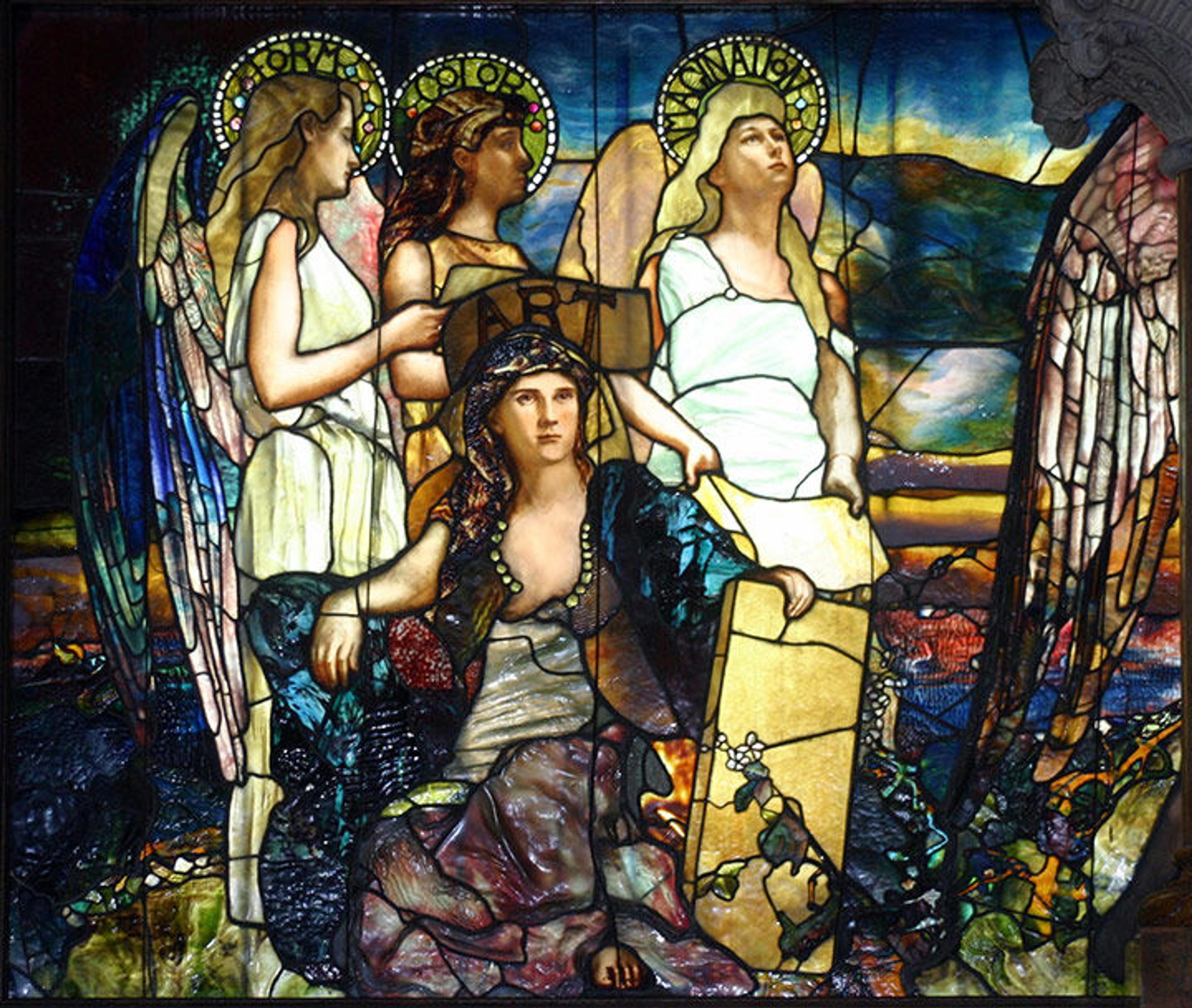
Louis Comfort Tiffany (American, 1848–1933); made by Tiffany Glass Co. (1885–1902). Education (Chittenden Memorial Window) (detail of the figure representing Art), c. 1890. Leaded glass window in Chittenden Hall (now Linsly-Chittenden Hall). Yale University, Gift of Simeon B. Chittenden, M.A.H. 1871. Public-domain photo via Wikimedia Commons
When considered together, the design drawing, painting, and glass window illuminate Tiffany's use of studio portrait photography to execute large artworks and commissions in a variety of mediums. The artist and his various enterprises, including Tiffany Studios, are recognized for their adventurous use of mediums. Photography was a relatively new invention when he began integrating it into his artistic and studio practices. Throughout his career Tiffany used photography for multiple purposes: Family portraits, stock photographs for artistic inspiration, documentation and publication of completed works, and the repurposing of designs for new commissions. Suggestion for Three Upper Windows in Large Hall for Residence of Mr. T. Eaton, Toronto, Canada is exceptional in that Tiffany's innovative use of photography encapsulates several of these areas.
Read Part Two of "What Lies Beneath a Tiffany Drawing" at Collection Insights.
Further Reading
Ruiz-Molina, Marina, and Christine Olson. "Drawing, Photography, and the Design of Tiffany Studios' Te Deum Laudamus Mosaic Triptych" in The Metropolitan Museum Journal51 (2016): 162–181.
Frelinghuysen, Alice Cooney. Louis Comfort Tiffany and Laurelton Hall: An Artist’s Country Estate. New York: The Metropolitan Museum of Art, 2006.
Frelinghuysen, Alice Cooney. Louis Comfort Tiffany at The Metropolitan Museum of Art. New York: The Metropolitan Museum of Art, 1999.
Marina Molina
Marina Ruiz Molina is an associate conservator in the Department of Paper Conservation.
Jalena Jampolsky
Jalena Louise Jampolsky was the 2016–17 Tiffany & Co. Foundation Curatorial Intern in American Decorative Arts in The American Wing.
Louisa Smieska
Louisa Smieska is the Andrew W. Mellon Postdoctoral Fellow in the Department of Scientific Research.